
1.Banks are -9% Off March Highs…..Let’s Keep Some Perspective.
KRE Regional Bank ETF…Rally post Trump then sideways.

10 Year Chart QQQ +178% vs. KRE Bank Stocks +12%
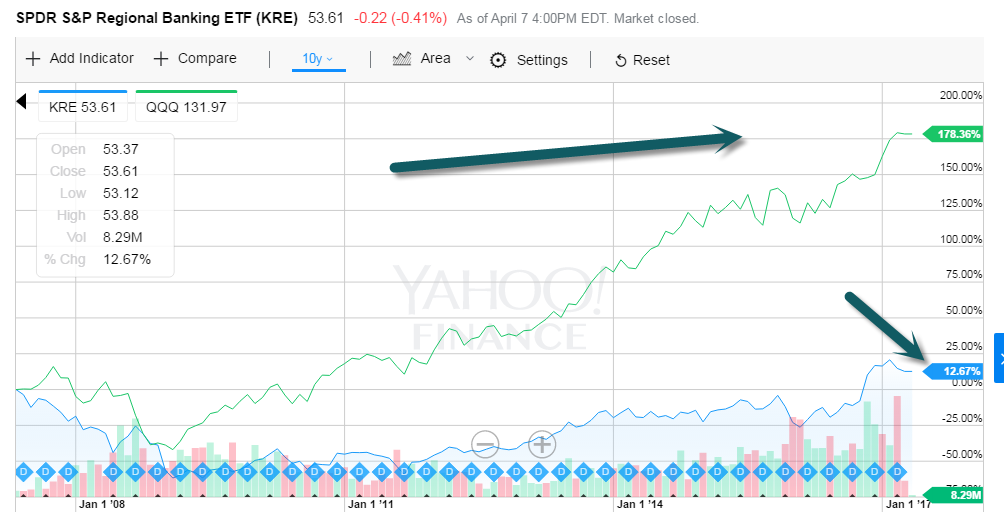 www.yahoofinance.com
www.yahoofinance.com
2.Global Dow Index Hits All-Time Highs Breaking Above 2015 Levels….International Outperforming U.S. YTD
50day thru 200day to upside on Chart.
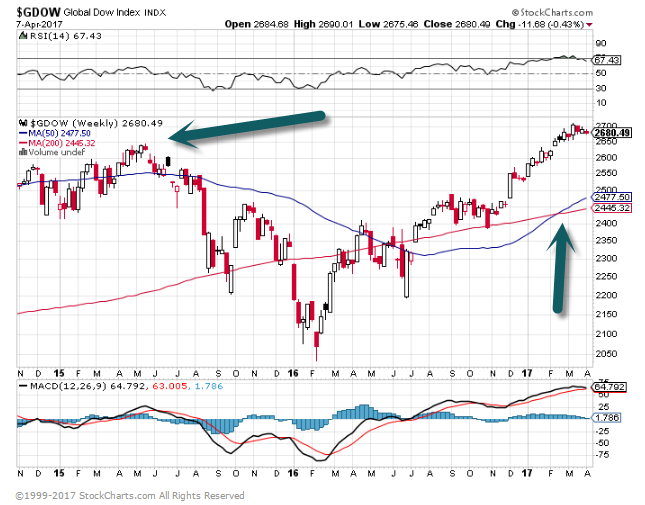 3.India Leads International Markets in 2017…..
3.India Leads International Markets in 2017…..
INDA +19% vs. Emerging Markets +12%
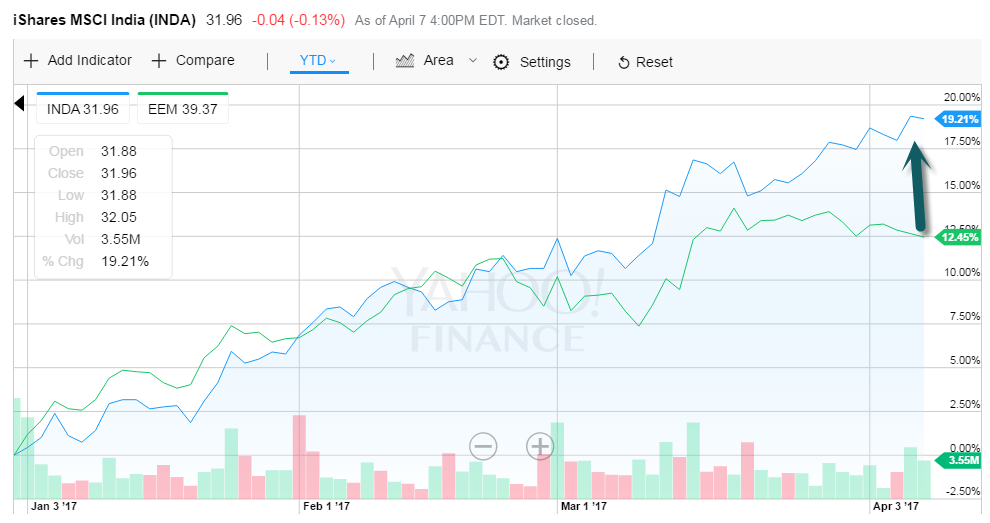 www.yahoofinance.com
www.yahoofinance.com
INDA India ETF About to Make New Highs.

www.stockcharts.com
4.Why will Electronic Bond Trading be a Different Animal?9300 Bonds in the Bloomberg Bond Index….200 Trade on a Daily Basis.
One Year Ago this Week….Here was the Chart of World Bond Yield.
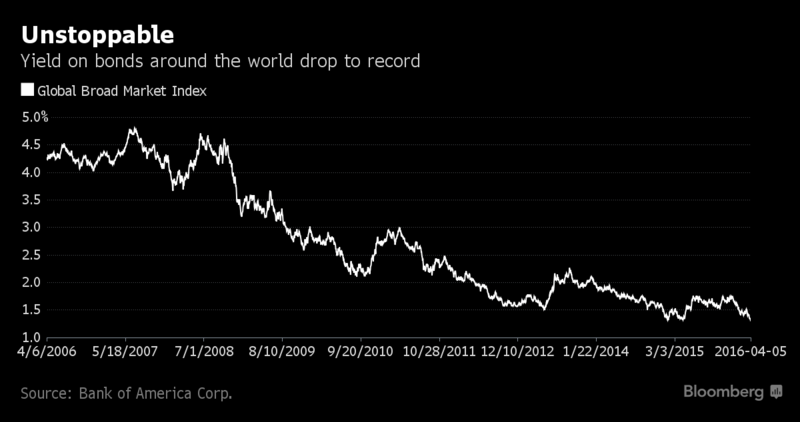
5.Safe to Say We are at Full Employment.
Torsten Slok Charts Deutsche Bank
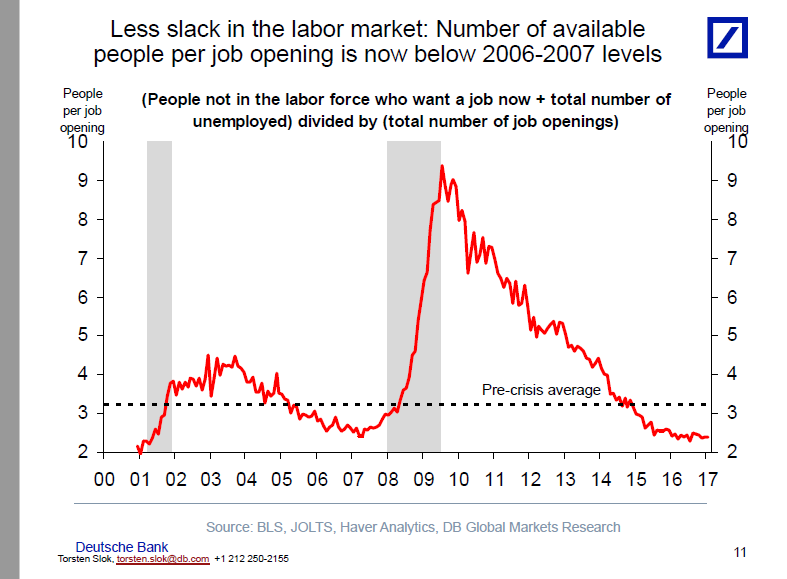
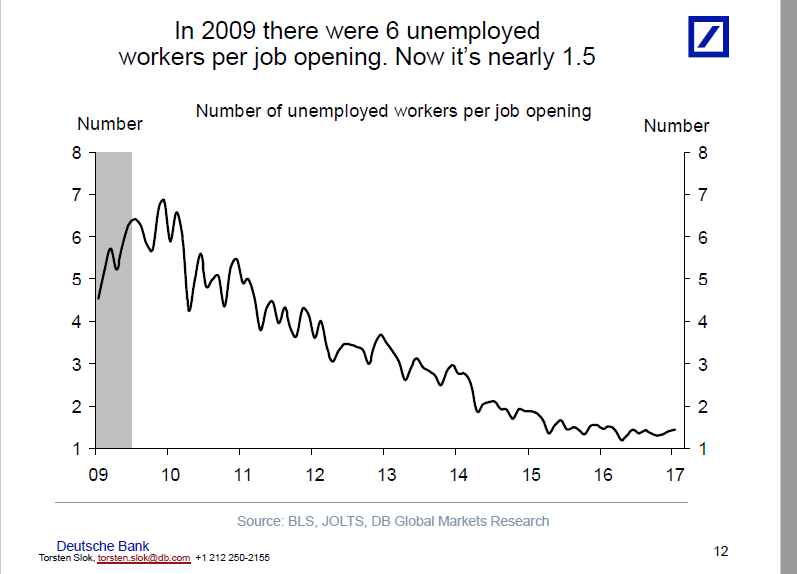
6.Credit Card Debt Hits $1 Trillion…..Joining Student and Car Loans.
America’s Credit-Card Tab Hits $1 Trillion
Credit-card debt hits its highest level since the last U.S. recession
Credit-card debt breached the $1 trillion threshold in the U.S., joining auto loans and student debt in crossing that level, and hitting its highest mark since the nation’s last recession.
The new data from the Federal Reserve marks the latest sign of a growing appetite for household debt. Rising consumer borrowing is often a positive sign for the U.S. economy as it typically means consumers are spending more on big-ticket items, such as cars, and smaller purchases often charged on cards. And while some are concerned about auto lending to risky borrowers and defaults on student loans, the quality of most credit-card debt remains strong.
New Federal Reserve data released Friday shows that U.S. consumers now owe $1.0004 trillion on credit cards, up 6.2% from a year ago and 0.3% from January. It is also the highest amount since January 2009
https://www.wsj.com/articles/the-nations-credit-card-tab-hits-1-trillion-1491593929?tesla=y

7.It’s Official….Car Loans, Student Loans and Credit Cards Over a Trillion.
Auto Loans Above $1 Trillion

Student Loan Debt Crosses $1 Trillion
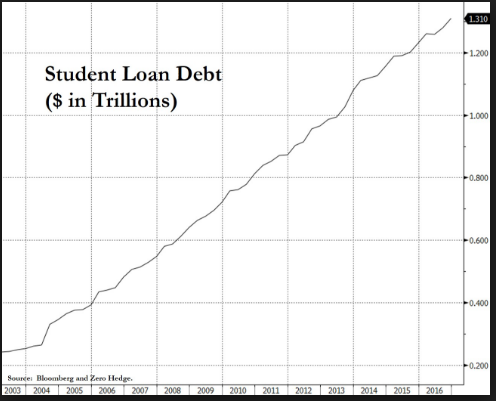
8.What fuels us
Data: U.S. Energy Information Administration Monthly Energy Review; Chart: Lazaro Gamio / Axios
Want the high-level view on U.S. energy consumption? The U.S. Energy Information Administration has you covered. It’s out with data showing total consumption ticked up slightly last year.
· Fossil fuels: They still rule the roost, accounting for 81 percent of total consumption in 2016, which is slightly less than 2015 and down from 86 percent in 2005. Petroleum and natural gas consumption both climbed last year, but that was more than offset by coal’s decline.
· Renewables: They saw the largest boost in consumption last year as wind power generation rose by nearly 20 percent and solar output climbed a lot as well.
· Nuclear: Consumption of nuclear energy rose 1 percent last year.
Want a really, really high-level view? Axios pulled years worth of EIA data into the chart above on U.S. energy consumption going back a quarter century. That downward staircase at the bottom illustrates how coal has lost market share at the expense of gas and renewables.
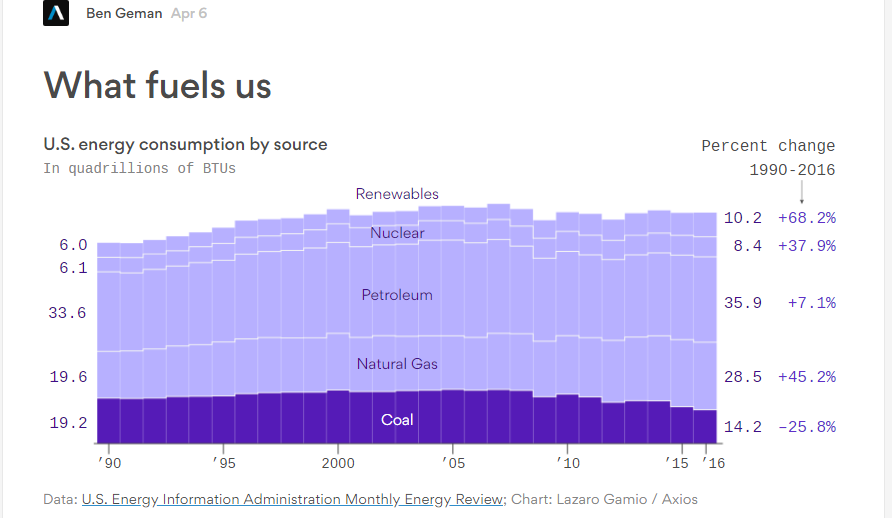
https://www.axios.com/what-fuels-us-2347418309.html
Found at www.abnormalreturns.com
9.Read of the Day….The Structural Decline of Fossil Fuels
Energy companies make up a material portion the indexes many advisors mirror, so they need to be wary of the long-term prospects for oil, coal and natural gas.
Garvin Jabusch | Apr 06, 2017
Energy companies make up a material portion of the S&P 500 and other indexes that some advisors mirror in client portfolios, so the sector’s growth prospects are meaningful to analyse thoughtfully.
Fossil fuels companies and supporters say that demand for their products is growing and will continue to do so for decades, if not indefinitely. Renewable energy companies, electric transportation providers and their advocates believe that the economics of their technologies will prove more advantageous than continued reliance on commodity-based energy. Who’s right? Let’s look at some of the arguments from the standpoint of a fossil fuel supporter and evaluate the facts.
Solar and wind still aren’t cost competitive. Not true. Electricity is being contracted at just under three pennies per kilowatt-hour (kWh), unsubsidized, from large-scale solar power generating plants. That’s $0.0299 per kWh in Dubai, which is one of the sunnier places in
the world and therefore particularly advantageous for solar, but we also see the United States not too far behind with San Jose, Calif., having signed a solar power purchase agreement for 3.7 cents per kWh, which is competitive with any form of fossil electricity and cheaper than most.
Wind, although not declining in price as rapidly as solar, is for now even cheaper. A 2015 report from analysts at Lazard Freres, as cited by Politifact, shows “the cost of wind production in Texas, not counting government subsidies, runs from $36 to $51 per megawatt-hour (mWh) while an average national cost for coal-fired electricity ranges from $65 to $150 per MWh and for gas, depending on the type of plant, from $52/MWh to $218/MWh.”
Solar and wind aren’t growing very fast. Solar is one of the world’s fastest growing industries, period. In a record-breaking year, “new solar capacity rose 50 percent in 2016,” according to the Guardian, and “globally there is now 305GW of solar power capacity, up from around 50GW in 2010 and virtually nothing at the turn of the millennium.” In the U.S., one could say solar energy is pulling the rest of the economy along with it: “the industry already provides more Americans with jobs than oil and gas extraction does, and it’s growing at 12 times the rate of general job creation,” according to a report from EDF.
Wind is booming almost as much. A four-year U.S. wind power forecast sees a quarter-million jobs and 35 gigawatts of new wind capacity in the U.S. by 2020.
Politically, there’s little to stop the growth of renewables. In addition to favorable economics, it turns out that climate science skepticism and support for wind and solar are not correlated as “renewable energy is popular — even among Trump voters and climate change deniers.”
Oil producers don’t agree there is a transition to renewables. At least one oil power, Saudi Arabia, thinks the oil era will end and is working hard on a transition plan to make the country much less dependent on fossil fuels revenues. The Deputy Crown Price has Bloomberg writing about “The $2 Trillion Project to Get Saudi Arabia’s Economy Off Oil.”
Natural gas is the fastest growing energy in America. Nope, it’s being outpaced by renewables 2-to-1. In 2015, solar and wind together represented 69 percent of new electricity generation capacity additions in the United States. New U.S. electrical capacity from wind and solar in January 2016? 100 percent. According to data cited by Joe Romm, “in the first three months of 2016, the U.S. grid added 18 MW of new natural gas capacity. It added a whopping 1,291 MW of new Wind and solar.” For the full year 2016, wind and solar represented 65 percent of new electricity generating capacity, while natural gas accounted for 35 percent, and coal contributed no new capacity.
Institutions don’t agree that the global economy will soon evolve past fossil fuels. On the contrary, they very much do. Morgan Stanley Research summed up the positions of many banks on the subject in writing: “Investors cannot assume economic growth will continue to rely heavily on an energy sector powered predominantly by fossil fuels.”
Electric vehicles will not displace internal combustion. According to Forbes, “the future is indeed electric, but if [gas engine car] manufacturers refuse to face the music, they may not be around for much longer. Bloomberg New Energy Finance, for instance, predicts that by 2040 the electric vehicle market will hit 41 million cars sold, “representing 35 percent of new light duty vehicle sales.””
Where is this momentum? The Dutch Parliament has passed legislation seeking to prohibit the sale of internal combustion engine cars in Holland after 2025. Prime Minister Modi and others in India are working toward similar policy that would ban the sale of gas and diesel burning cars in India after 2030. According to The Independent, “Norway will ban the sale of all fossil fuel-based cars in the next decade, continuing its trend towards becoming one of the most ecologically progressive countries on the planet.” Bloomberg has written that they think there will be enough electric vehicles on the road by 2022 to have displaced 2 million barrels of oil per day worth of demand, with demand displacement of five, 10, and 15 million barrels not far behind. The Energy Collective has written that they don’t see any scenario where electric vehicles are not the majority of cars on the road globally by 2050. The Financial Times has gone as far as to print that fossil fuels must now accept that they are entering terminal decline.
Fossil fuels may never be abandoned completely, but there is no clear scenario where they will be able to resume long-term growth or a reliable pattern of risk-adjusted returns. Renewable energies have become too economically competitive for fossil fuels to contend with in new electricity generation. Transportation, though not as far advanced in evolving beyond fossils, is slowly but inexorably heading that way.
It’s hard to see where an increase in demand for fossil fuels can come from. The transition to a global economy powered by wind and solar is no longer a theoretical revolution, it is now demonstrably underway. For investors, it has become dangerous to think of fossil fuel stocks as the same source of safe risk-adjusted returns that they were in past decades, and perhaps equally dangerous to assume that stranding of fossil fuel reserves is a process that will take decades. Noted investor Jeremy Grantham thinks that before 2030, investment growth in fossil fuels will have stopped. Green Alpha Advisors believes it will be long before that.
Garvin Jabusch is co-founder of Green Alpha Advisors
http://www.wealthmanagement.com/equities/structural-decline-fossil-fuels?NL=WM-27&Issue=WM-27_20170408_WM-27_500&sfvc4enews=42&cl=article_4&utm_rid=CPG09000007333628&utm_campaign=9046&utm_medium=email&elq2=9eccd2e5b19a4b19b68eb3cd4e1af4c4
10. Secrets to a Less Stressful Life
Lisa Firestone Ph.D.Compassion Matters
Secrets to a Less Stressful Life
How to best handle the waves of stress that have entered our lives.
Posted Apr 07, 2017
You’re at your desk, about to log off for your lunch break, when you hear the ding of an incoming text. You read the message from your partner saying, “Meeting got moved. Can’t get kids from school today.” By the time you glance back up at your screen, an email has come in from your boss, asking about the progress of a lagging project. As you craft your reply, your phone beeps again, and you eagerly check for the life-saving words of your best friend saying she can pick up your kids, but instead, you’re greeted by a news alert about some unspeakable thing happening in what seems to be an increasingly insane world.
Fill in the blanks of your own latest text, email, and news alert, and most of you can probably relate to this scenario. In fact, the American Psychological Association (APA) recently reported that the constant checking of devices is contributing to high levels of stress for the majority of Americans. This year, results from an APA survey also showed a “statistically significant increase” in stress for the first time since the survey was first conducted in 2007. Stress is on the rise for myriad reasons that are worth examining. But here, I want to explore how to best handle the new waves of stress that have entered our lives. No matter what it is that’s making each of us anxious, we can all arm ourselves with the tools to help us stay calm, centered, and feeling strong in the face of challenges. Here are some techniques we can adopt to better handle moments of stress.
1. Get a hold of your inner critic: One thing we should realize about stress is that so much of what we worry about is based not just on what’s happening in our lives but the messages we tell ourselves about what’s happening. Facing a deadline is stressful, but it’s those nagging thoughts telling us, “You’re never going to finish” or “This is all gonna blow up in your face” that really get us worked up. Getting our kid to finish their homework is tiring, but it’s made all the worse by attacks like “You’re a terrible parent” or “You can’t even get your own kid to listen to you. What a failure!” Take the time to ask yourself, “what are the thoughts around my stress that perpetuate it?”
There are a lot of things in our lives that don’t go our way or that we can’t control, but what makes matters much worse is a “critical inner voice” we all possess that punishes us unnecessarily and escalates our stress. “How can you sleep? You have so much to do.” “What makes you think you can just relax?” “This is just too much. You can’t handle it.” This voice is a friend to our stress, paving a tunnel for it to pour in and consume our state of mind. Identifying our “inner critic” by noticing when it starts yammering away will help us peel away its negative messaging from whatever our actual circumstances may be.
2. Practice pressing the pause button: The saying, “whatever you practice gets stronger” is a useful one to remember when it comes to stress. If you practice stress, it will become the norm. If you practice calming yourself, it can also become the norm. When you feel your emotions start to spiral out or overpower you, remind yourself to take just one moment to pause and tune in to yourself. Take a few deep breaths, and slow down your thoughts. You might even put one hand on your belly and another on your heart, while you breathe in and out. This will help you feel more centered.
3. Embrace mindfulness (without judgment): William James said, “The greatest weapon against stress is our ability to choose one thought over another.” Mindfulness is a practice of, not necessarily choosing our thoughts, but choosing how we react to our thoughts and not letting them take over. Mindfulness meditation, for example, teaches us to focus on our breath and tune in with our bodies. As we do this, we can notice individual thoughts as if they are train cars passing on a track. We can acknowledge each one without choosing to board the train and disappear into a land of worry.
Mindfulness teaches us to remain in the moment. The philosopher Lao Tzu said, “If you are depressed you are living in the past. If you are anxious you are living in the future. If you are at peace you are living in the present.” So much of our stress has to do with feeling bad about the past or worrying about the future, but what many of us find is that in the present moment, we are often okay.
article continues after advertisement
4. Give yourself permission to stop worrying: A lot of our stress is about what we can’t control, yet we all indulge in some degree of magical thinking that tells us that somehow worrying or considering every potential negative outcome will solve the problem or at least protect us. Rather than repeatedly setting off warnings in our heads that tell us to panic, why not give ourselves permission to stay in the moment and deal with what is rather than what might be? We could give ourselves permission to let go of the bad thoughts and feelings as much as possible. We can do this each time we’re faced with a challenge. It’s possible to confront the reality of a situation without adding the extra weight of torturing ourselves about the possible scenarios of this reality or its potential consequences.
5. Be around people who make you feel good: In a recent article in The Atlantic addressing post-election stress, Jack Saul, the director of the International Trauma Studies Program, said, “Strengthening connections with families, communities, and organizations is the most important preventive approach.” Studies show that friendship itself is a natural and effective antidote to stress. It’s important to surround ourselves with the right kind of friend, one who keeps us on the right side of ourselves.This means a friend who doesn’t perpetuate our stress by encouraging us to ruminate or wallow in our worries or who doesn’t add to it by joining in and stressing along with us. Find positive people, who have an easier time staying calm or who are more resilient and less hyper-reactive to problems.
6. Try out a different perspective: On a survival level, our brains are wired to notice danger and focus on potential problems in an attempt to protect us. Unfortunately, this can make it much too easy to become overwhelmed by things we can’t control. Dr. Salvatore Maddi, who’s studied “hardiness” or emotional resilience for more than 30 years, has found that people with more hardiness see challenges as part of the human condition and regard them as opportunities to change and gain strength. Imagine that moment when life hands us something we could so easily stress about. If we feel overpowered by our circumstances, we may give up, get upset, or engage in a lot of thoughts and behaviors that amplify our stress. If we take a moment to pause to see this instead as a challenge, a natural bump in the road of life, we can change the way we feel inside when facing the very same external circumstances.
article continues after advertisement
7. Make self-compassion a permanent goal: Dr. Kristin Neff is a lead researcher on self-compassion. She has discovered incredible benefits to practicing self-compassion, as it helps people avoid self-evaluation, while allowing them to be kind to themselves. Self-compassion is sometimes mistaken for feeling sorry for oneself, but it is actually the opposite. It allows us to feel for ourselves and our circumstances and accept our suffering as part of the human condition. It allows us to see our flaws or limitations without hating ourselves, and therefore, we can take steps to make changes. Self-compassion can be a powerful tool when we feel stressed, because it reminds us to be kind and sensitive to ourselves and treat ourselves the way we would a friend facing these same circumstances.
8. Develop strategies to calm yourself down: There are many good exercises for reducing our immediate feelings of stress. Breathing exercises such as taking a few long, slow breaths or simply paying attention to our breath, even yawning or inflating a balloon, can help us lower our heart rate and calm down. In terms of our thinking, there are practices to help us better process what’s occurring. When something painful or distressing happens, for example, psychologists Jack Kornfield and Tara Brach recommend the RAIN Approach, which involves Recognizing the trauma or loss, Acknowledging/ Accepting/ Allowing that this trauma occurred and may not be resolved, Investigating the experience as it relates to your past and present life, and Non-identification with the experience, which means we don’t over-identify with what happened or allow it to define us.
Learn more tools and techniques for coping with anxiety.
9. Notice the triggers that set you off: We all have real stressors in our lives (bills to pay, work to do, schedules to manage), but why are we able to handle some things with calm and competence, while others seem to push us over the edge? We all have specific buttons that set off our stress more than others. The more we learn what triggers our strongest emotions, like fear and frustration, the more we can understand ourselves and control our reactions to these triggers. For example, does a tone of condescension set off critical inner voices of being incapable? Is the nightly news making you feel like hiding under a desk? Does a certain way your child cries leave you feeling unbelievably overwhelmed?
article continues after advertisement
When we identify these triggers, we can go deeper into exploring why these particular things stir us up so much. Maybe they remind us of feeling helpless as a child or having a parent who flew off the handle. Maybe they trigger real or existential fears about ourselves and our family. Knowing our triggers can help us face more core emotions that are pumping life into our stress, and they can also teach us what may not be best for us in our daily lives. We should ask ourselves, “Can I avoid, limit, or better handle certain things that make me feel stressed?” Can I put away my phone after 9PM? Can I turn off the news when my heart starts to race? Can I take a couple smaller projects off my calendar? Can my partner handle this tantrum when I’m not feeling myself? This approach isn’t about eliminating or avoiding real responsibilities or circumstances, but about actively seeking better strategies to deal with them.
10. Take positive actions: At times, stress can make us feel overwhelmed or hopeless and can actually impair our ability to take action. If we feel stressed, it can be beneficial to sit down and come up with some actions that will help alleviate our stress rather than contribute to it. This isn’t about making a long to do list that will overwhelm or agitate us; it’s about taking pause and really pinpointing a positive step we can take to feel better or move forward on a task. This could be something as small as going for a walk outside, taking 15 minutes to meditate, setting aside an hour to make progress on a project, calling a good friend, or listening to uplifting music.
These actions can also be a direct response to whatever is causing our stress. For example, if we feel frustrated by the state of the world, we can set up time to volunteer or donate to a cause that matters to us. If work is chaotic, we can seek out strategies to keep calm. One friend of mine found it helpful to just check in with herself every hour to ask, “how are you hanging in there?” and taking a few moments to breathe. If we’re overwhelmed at home, we can engage in a healthy conversation with family or friends about how we can all help one another. My sisters often pick up each other’s kids once or twice a week to allow the other to have an extra hour at the end of the day. Another friend makes a game out of late-night grocery shopping with his whole family when he or his wife has trouble making time to get to the market. Whatever it is that helps, give that action the time and importance it deserves. Anything we can do to help squeeze more joy, peace, and meaning out of our day is a worthy pursuit that everyone deserves.
https://www.psychologytoday.com/blog/compassion-matters/201704/secrets-less-stressful-life